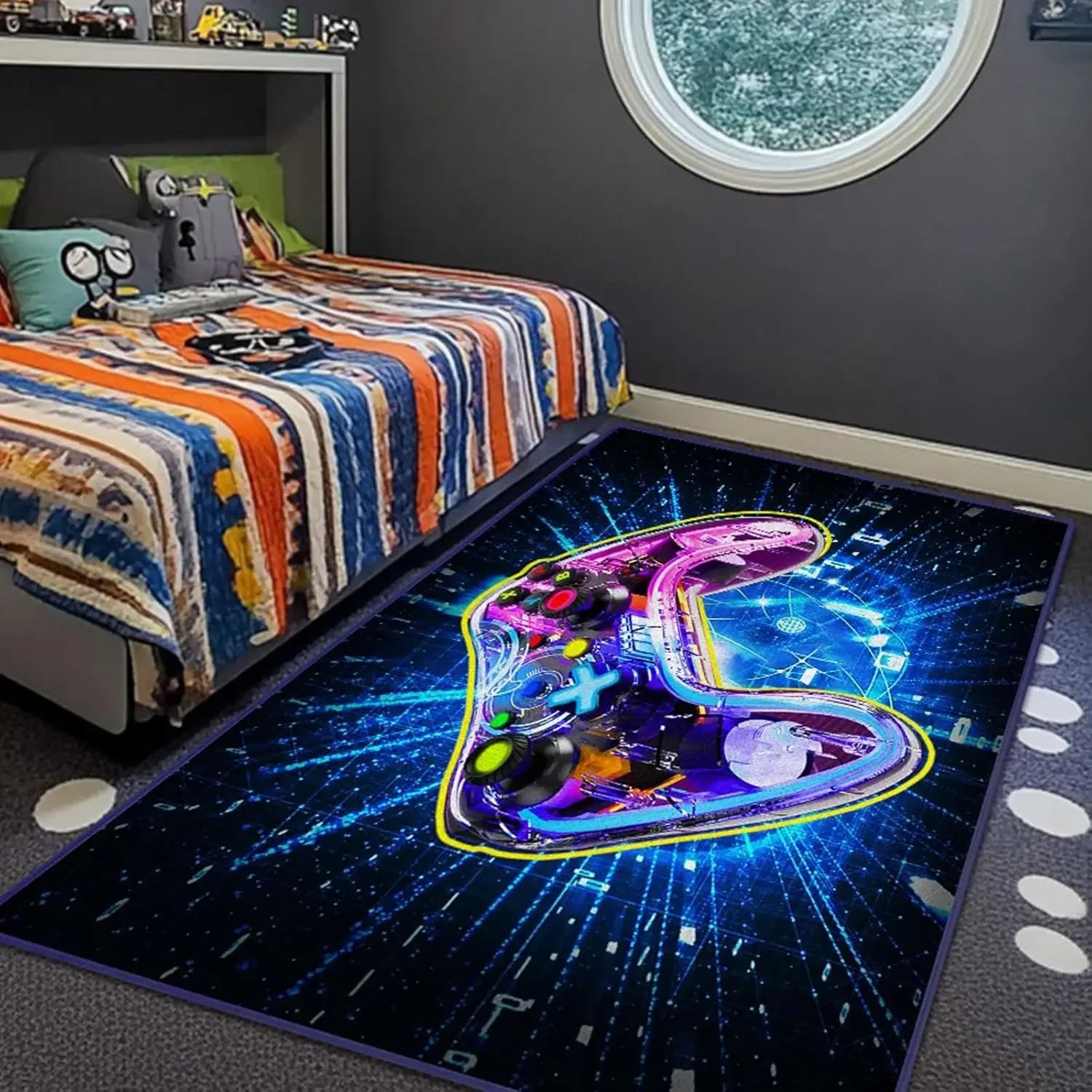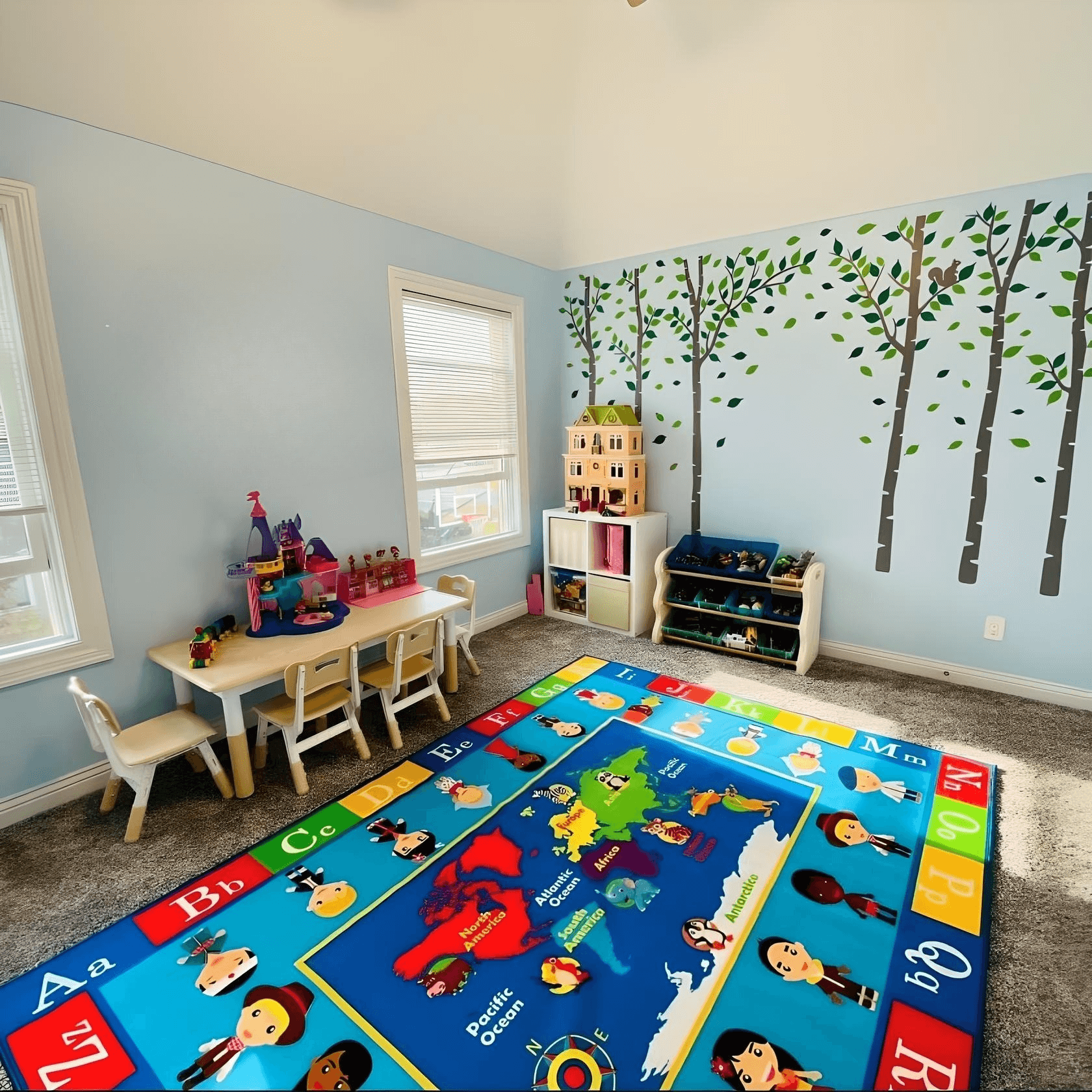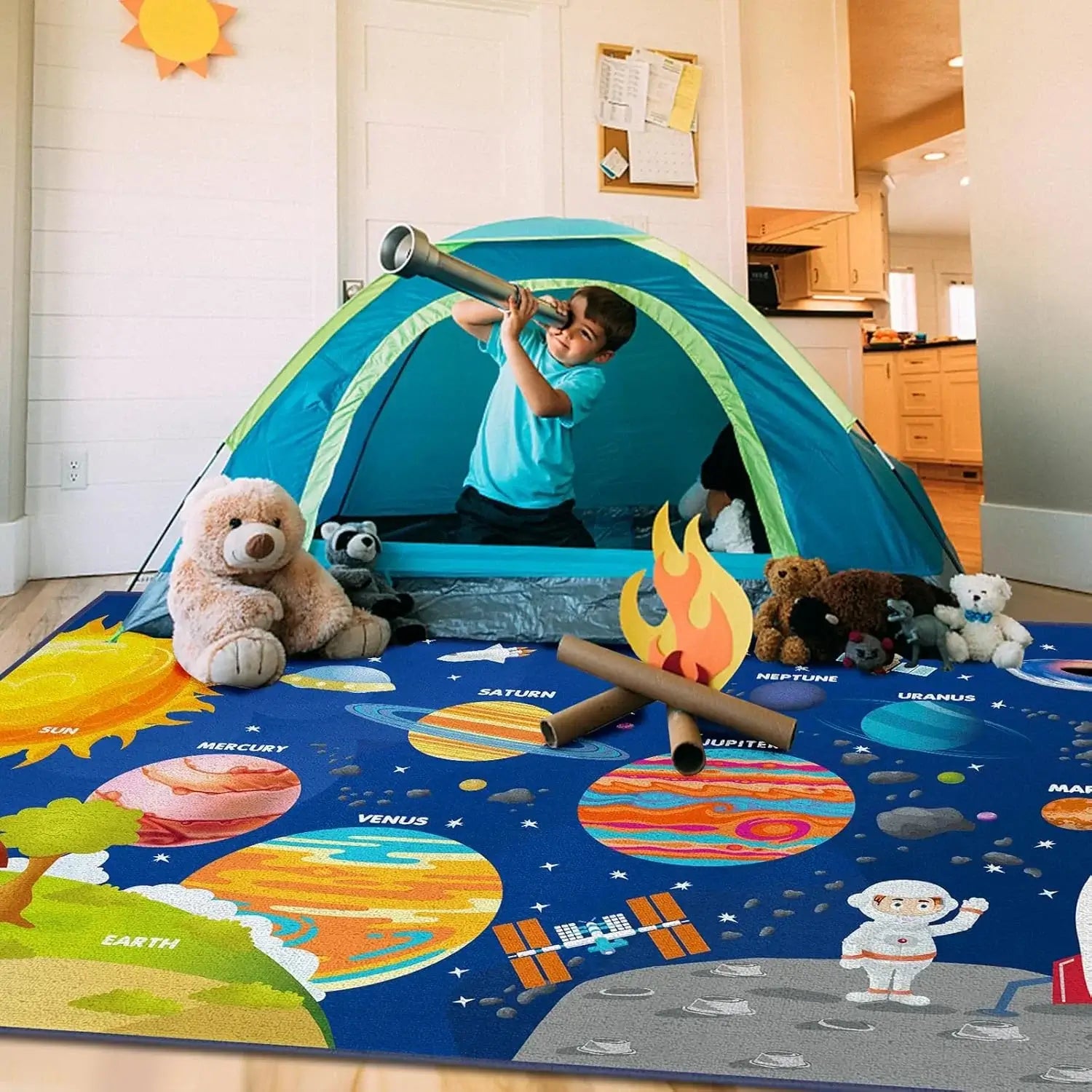Today's multifunctional children's rugs are designed with creativity in mind, offering endless possibilities for imaginative use. From educational tools to party decorations, portable play spaces to therapeutic aids, these versatile pieces can adapt to your family's changing needs in ways you might never have considered.
According to child development experts at Harvard's Center on the Developing Child, children learn best through hands-on, interactive experiences. Creative use of familiar objects like rugs can enhance learning, spark imagination, and provide new sensory experiences that support healthy development.
Educational Adventures: Rugs as Learning Tools
Transform ordinary rugs into powerful educational instruments that make learning fun and interactive:
Geographic Exploration Maps
Turn alphabet or number rugs into world exploration tools. Use toy cars to "drive" between letters while discussing countries that start with each letter. Place small world landmarks (toy pyramids, mini Eiffel Towers) on corresponding letters to create geography lessons.
Math Manipulation Station
Number rugs become instant math classrooms. Use colorful blocks, beans, or small toys as counters. Children can physically hop from number to number while learning skip counting, or use the spaces between numbers for addition and subtraction problems.
Alphabet Adventure Courses
Create obstacle courses using alphabet rugs as stations. At each letter, children perform an action that starts with that letter: "A" for animals (act like different animals), "B" for balance (stand on one foot), "C" for counting (count to ten).
Science Experiment Base
Use solid-colored rugs as contained spaces for messy science experiments. The defined boundary helps children understand their workspace while protecting surrounding areas. According to Scholastic's early learning experts, bounded spaces help children focus better on detailed tasks.
Reading Comprehension Circles
Arrange multiple small rugs in a circle for group reading activities. Each child gets their own defined space while remaining part of the group dynamic. This setup works particularly well for book discussions and storytelling activities.
Imaginative Play Transformations
Unlock your child's creativity by transforming rugs into magical play environments:
Flying Carpet Adventures
Any rug can become Aladdin's magic carpet! Children sit on the rug and "fly" to different destinations, describing what they see below. This activity combines physical play with storytelling and geographical awareness.
Pirate Ship Decks
Rectangular rugs transform into pirate ships. Add pillows as "cannons," use jump ropes as "rigging," and let children navigate the seven seas from their rug vessel. Imaginative play experts at the American Academy of Pediatrics emphasize that this type of role-playing supports emotional development and problem-solving skills.
Restaurant and Café Setup
Use rugs to define restaurant spaces. One rug becomes the kitchen, another the dining area. Children can practice social skills, math (with play money), and responsibility while running their pretend establishment.
Castle Courtyards
Large square or rectangular rugs serve as castle grounds. Build pillow towers at corners, create "moats" with blue fabric strips around the perimeter, and let children defend their kingdoms or host royal tea parties.
Time Machine Platforms
Transform rugs into time machines by adding cardboard "control panels." Children step onto the rug, set their destination era, and emerge to explore different time periods through dress-up and roleplay.
Party and Event Magic
Children's rugs can elevate party planning and special events in unexpected ways:
Musical Shapes Game
Use multiple small rugs instead of traditional musical chairs. When music stops, children must find a rug to stand on. Gradually remove rugs to increase excitement. This variation is safer than musical chairs and works well indoors.
Themed Party Zones
Create distinct party areas using different rugs. Use a space-themed rug for a "rocket launch" station, an ocean rug for a "submarine dive" area, and a jungle rug for a "safari adventure" zone. Each area can have themed activities and decorations.
Photo Booth Backdrops
Hang colorful or patterned rugs as photo booth backgrounds. The textures and patterns add visual interest to party photos while creating a defined photo area that guests naturally gravitate toward.
Game Tournament Arenas
Set up multiple rugs as game stations for party tournaments. Each rug becomes a designated area for different activities: board games, card games, puzzle challenges, or craft stations.
Treasure Hunt Markers
Use small rugs as treasure hunt stations. Each rug marks a clue location and provides a comfortable gathering spot for teams to solve puzzles together.
Outdoor Adventures
Extend your rug's usefulness beyond indoor spaces:
Picnic and Beach Companions
Weather-resistant rugs make excellent alternatives to traditional picnic blankets. They're easier to shake clean, more durable against rough surfaces, and provide better cushioning for extended outdoor sitting.
Garden Play Spaces
Create temporary outdoor play areas using rugs to define garden play spaces. Children can have tea parties, read books, or play quiet games without getting dirty from grass or soil.
Camping Comfort Zones
Pack lightweight rugs for camping trips to create comfortable areas outside tents. They provide extra insulation from ground cold and define personal spaces in shared camping areas.
Pool and Water Play Bases
Use water-resistant rugs around kiddie pools or sprinkler areas. They provide non-slip surfaces for wet feet while defining the play zone and protecting underlying surfaces.
Outdoor Movie Nights
Roll out rugs as comfortable seating for backyard movie screenings. Layer multiple rugs to accommodate larger groups and create a cozy outdoor theater experience.
Sensory and Therapeutic Uses
Leverage rugs' therapeutic potential for children with different needs:
Sensory Processing Support
Different rug textures provide various sensory inputs. Shaggy rugs offer deep pressure sensation, smooth rugs provide gentle tactile input, and textured rugs can help with sensory integration. Occupational therapy research shows that varied textures support sensory development.
Calming Down Spaces
Designate specific rugs as "calm down" areas where children can go when feeling overwhelmed. The consistent, defined space helps create a sense of security and provides a routine response to emotional challenges.
Meditation and Mindfulness Circles
Use round rugs for family meditation or mindfulness activities. The circular boundary naturally creates a feeling of unity and focus, while the soft surface encourages relaxation.
Physical Therapy Exercises
Consult with physical therapists about using rugs for specific exercises. The defined space helps children understand boundaries while the cushioned surface provides joint protection during floor exercises.
Balance and Coordination Training
Thick rugs create slightly unstable surfaces that challenge balance and proprioception. Simple standing, walking, or playing on these surfaces can improve coordination skills.
Storage and Organization Hacks
Transform rugs into practical organizational tools:
Toy Corral System
Use rugs as "toy corrals" during playtime. When children finish playing with one set of toys, everything must be collected back onto the designated rug before moving to the next activity. This system teaches cleanup responsibility and organization.
Laundry Sorting Stations
Assign different colored rugs for different types of laundry sorting. Children can help by placing clothes on the correct rug: whites on the white rug, darks on the dark rug, etc.
Seasonal Storage Solutions
Roll rugs around seasonal decorations or bulky items for compact storage. The rug protects items while staying useful, and everything can be stored together in closets or under beds.
Art Supply Workshops
Lay out rugs as art stations with specific supplies on each one. One rug holds drawing supplies, another holds painting materials, and a third holds craft supplies. This organization helps children choose activities and maintain supplies.
Reading Library Sections
Use different rugs to organize books by category or reading level. Picture books on one rug, chapter books on another, and reference materials on a third creates a home library system children can navigate independently.
Travel and Portable Solutions
Maximize rug utility during travel and outings:
Airport and Travel Comfort
Pack lightweight rugs for airport layovers or long travel days. They provide clean, comfortable surfaces for children to sit and play while waiting, and they're much more hygienic than public floor surfaces.
Hotel Room Familiarization
Bring a familiar rug to hotel rooms to create instant comfort zones for children. The familiar texture and appearance can help children feel more secure in unfamiliar environments.
Car Trip Entertainment
Use small rugs as car activity bases. Children can use them in hotel rooms, rest stops, or picnic areas to create consistent play spaces throughout road trips.
Grandparents' House Essentials
Keep rugs at frequently visited relatives' homes to create consistent play areas. This helps children feel more comfortable and provides designated toy areas that respect grandparents' home organization.
Daycare and School Supplements
Some daycares and schools allow personal comfort items. A small, washable rug can provide sensory comfort during rest time or create a personal space during group activities.
Seasonal Decorating
Rotate rugs to match seasons and holidays:
Holiday Transformations
Switch out rugs to match holiday themes. Use autumn-colored rugs for fall decorating, winter-themed rugs for holiday seasons, and bright, floral patterns for spring celebrations.
Weather Adaptation
Rotate between thick, cozy rugs for winter warmth and lighter, brighter rugs for summer freshness. This seasonal rotation keeps rooms feeling current while extending rug life through reduced continuous use.
Birthday Month Features
Designate special birthday rugs that only come out during birthday months. This creates anticipation and makes birthday celebrations feel more special and personalized.
School Year Transitions
Switch to "back to school" themed rugs at the beginning of each school year. Educational patterns, alphabet designs, or school-color themes can help children transition into learning mode.
Growth Milestone Markers
Use special rugs to commemorate growth milestones: potty training success, first day of school, learning to read. The rug becomes a physical reminder of achievement and progress.
DIY Craft Projects
Transform old or damaged rugs into new creations:
Wall Art Installations
Frame sections of beautiful rugs as wall art. This works particularly well with geometric patterns or interesting textures that add visual dimension to room decor.
Pet Bed Upcycling
Convert outgrown children's rugs into comfortable pet beds. The familiar scents and textures often comfort pets while giving rugs extended useful life.
Garden Pathway Markers
Weather-resistant outdoor rugs can be cut into shapes and used as garden pathway markers or plant area definitions in family gardens.
Dollhouse Carpeting
Cut small sections from damaged rugs to create realistic carpeting for dollhouses or other miniature play setups. This adds authentic detail to imaginative play environments.
Memory Quilts
Combine sections from meaningful rugs with fabric to create memory quilts that preserve childhood room memories while creating new functional items.
Special Needs Applications
Rugs can provide unique support for children with special needs:
Autism Spectrum Support
Consistent rug placement can help children with autism navigate spaces more predictably. According to Autism Speaks research, environmental consistency supports comfort and reduces anxiety for many children on the spectrum.
ADHD Focus Enhancement
Defined rug boundaries can help children with ADHD maintain focus during activities. The physical boundary reinforces mental boundaries and provides clear workspace definition.
Physical Disability Accommodation
Thick, cushioned rugs provide safer surfaces for children with balance or mobility challenges. They offer fall protection while maintaining dignity and independence during floor play.
Vision Impairment Navigation
High-contrast or textured rugs can serve as tactile landmarks for children with vision impairments, helping them navigate familiar spaces more independently.
Hearing Impairment Considerations
Rugs reduce sound transmission, which can be particularly beneficial in homes with children who have hearing aids or cochlear implants, as they reduce echo and background noise.
Safety and Practical Tips
When using rugs creatively, keep these safety considerations in mind:
Slip Prevention
Always use rug pads or non-slip backings when using rugs in unconventional ways. Creative positioning often means rugs aren't in their designed flat positions, increasing slip risks.
Weight Distribution
When using rugs as play surfaces for multiple children, ensure weight is distributed evenly. Avoid activities that could cause bunching or uneven stress on rug fibers.
Supervision Requirements
Many creative rug uses require additional supervision, especially when children are using rugs in non-traditional ways or combining them with other play materials.
Cleaning Considerations
Increased handling and creative use may require more frequent cleaning. The American Academy of Pediatrics recommends regular cleaning of all fabric items in children's environments to reduce allergen exposure.
Age Appropriateness
Consider children's developmental stages when implementing creative rug uses. What's safe and appropriate for school-age children may not be suitable for toddlers.
Conclusion
Children's rugs are far more versatile than most parents realize. By thinking beyond traditional floor covering, you can maximize your investment while providing children with rich, varied experiences that support learning, creativity, and development.
From educational adventures to party magic, outdoor exploration to therapeutic support, the possibilities are limited only by imagination. Quality rugs from Booom Jackson are designed to withstand creative use while maintaining their beauty and functionality.
Remember that the best multifunctional rug use combines safety with creativity. Always supervise new activities, ensure proper setup, and most importantly, have fun exploring all the wonderful ways children's rugs can enrich your family's daily life.
The next time you look at your child's rug, don't just see a floor covering—see a magic carpet, a learning laboratory, a party platform, and a gateway to countless adventures waiting to unfold!




Leave a comment
This site is protected by hCaptcha and the hCaptcha Privacy Policy and Terms of Service apply.